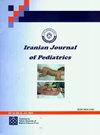Evaluation of Serum Zinc Levels in Children of 6 Months to 5 Years of Age Diagnosed with Simple Febrile Seizures
IF 0.4
4区 医学
Q4 PEDIATRICS
引用次数: 0
Abstract
Background: Febrile seizures are defined as seizures associated with a febrile illness that developed without central nervous system infection or acute electrolyte imbalance, intoxication, trauma, and metabolic disorder in children aged 1 month to 5 years without previous afebrile seizures. Various studies show a relationship between zinc levels and febrile seizures. Objectives: The purpose of this study was to examine the relationship between serum zinc levels and febrile seizures. Methods: This prospective, cross-sectional, and descriptive study was conducted from 04/10/2021 to 04/02/2022. A total of 85 children aged 6 months to 5 years admitted to the pediatric emergency service of the Republic of Turkey Ministry of Health Cemil Taşcıoğlu City Hospital were included in the study. The patients who met the inclusion criteria and whose consent was obtained were included in the study. Complex and febrile status patients were not included in the study due to the small number of patients. The cases included in the study were divided into 2 groups of patients and healthy controls. The patients with fever were divided into 2 groups, including those with and without febrile seizures. The levels of zinc and complete blood count parameters were measured in the blood samples taken from all the patients. IBM SPSS 22 package software was used for the statistical examination of the data. Results: When the cases included in this study were divided according to gender, 33 (38.8%) and 52 (61.2%) patients were female and male, respectively. The mean age of the cases was 29.2 ± 15.9 months (range: 6 - 60). Of the 85 participating cases, 30 patients had febrile seizures, 30 were only febrile patients, and 25 were healthy controls. When zinc levels were compared between the groups, the plasma zinc levels of the febrile seizures and febrile groups were observed to be lower than the healthy control group (P < 0.05). Conclusions: In this study, the group consisting of patients with febrile seizures and the groups of patients who had a fever but did not have febrile seizures during the study had reduced serum zinc levels than the control group consisting of healthy patients without fever.评价6个月至5岁诊断为单纯热性惊厥的儿童血清锌水平
背景:发热性惊厥是指在1个月至5岁无发热性惊厥史的儿童中,无中枢神经系统感染或急性电解质失衡、中毒、创伤和代谢紊乱的发热性疾病相关惊厥。各种研究表明锌含量与发热性癫痫发作之间存在关系。目的:本研究的目的是研究血清锌水平与热性惊厥之间的关系。方法:本前瞻性、横断面、描述性研究于2021年10月4日至2022年2月4日进行。共有85名6个月至5岁的儿童在土耳其共和国卫生部塞米尔Taşcıoğlu市医院儿科急诊科就诊。符合纳入标准并获得同意的患者被纳入研究。由于患者数量少,复杂和发热状态患者未纳入研究。纳入研究的病例分为两组患者和健康对照组。发热患者分为有发热惊厥和无发热惊厥两组。在所有患者的血液样本中测量锌水平和全血细胞计数参数。采用IBM SPSS 22软件包软件对数据进行统计检验。结果:本研究纳入病例按性别划分时,女性33例(38.8%),男性52例(61.2%)。患者平均年龄29.2±15.9个月(6 ~ 60岁)。85例患者中,30例有热性惊厥,30例仅为热性惊厥,25例为健康对照。比较两组间锌水平,热惊厥组和热惊厥组血浆锌水平均低于健康对照组(P < 0.05)。结论:在本研究中,由发热性惊厥患者组成的组和在研究期间有发热但没有发热性惊厥的患者组成的组的血清锌水平低于由无发热的健康患者组成的对照组。
本文章由计算机程序翻译,如有差异,请以英文原文为准。
求助全文
约1分钟内获得全文
求助全文
来源期刊
CiteScore
0.90
自引率
20.00%
发文量
75
审稿时长
6-12 weeks
期刊介绍:
Iranian Journal of Pediatrics (Iran J Pediatr) is a peer-reviewed medical publication. The purpose of Iran J Pediatr is to increase knowledge, stimulate research in all fields of Pediatrics, and promote better management of pediatric patients. To achieve the goals, the journal publishes basic, biomedical, and clinical investigations on prevalent diseases relevant to pediatrics. The acceptance criteria for all papers are the quality and originality of the research and their significance to our readership. Except where otherwise stated, manuscripts are peer-reviewed by minimum three anonymous reviewers. The Editorial Board reserves the right to refuse any material for publication and advises that authors should retain copies of submitted manuscripts and correspondence as the material cannot be returned. Final acceptance or rejection rests with the Editors.

 求助内容:
求助内容: 应助结果提醒方式:
应助结果提醒方式:


